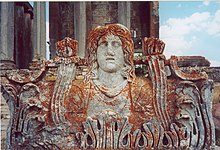Aizanoi
Coordinates: 39 ° 12 ' N , 29 ° 37' E
Aizanoi ( ancient Greek Αἰζανοί , Latin Aezani ) is an ancient city in the Phrygia countryside in Asia Minor (today Turkey , near Çavdarhisar , about 50 km southwest of Kütahya ). It lies in the valley of the Bedir Çayı ( Penkalas ), a source river of the Kocaçay ( Rhyndakos ). Extensive excavations make Aizanoi a well-researched example of a smaller city, especially during the time of the Roman Empire .
According to the founding legend, the city was founded by Arcadian settlers. A settlement has archeologically already for the 3rd millennium BC. A more extensive settlement emerged only in the Hellenistic period. Around 200 BC The area in which Aizanoi is located came to the Kingdom of Pergamum as Phrygia epiktetos ("additionally acquired Phrygia") ; for a time it also belonged to Bithynia . The Pergamene kings settled mercenaries who probably came from Macedonia . Along with its entire empire, the city went under after 133 BC. In the Roman province of Asia .
Aizanoi experienced a great boom in the early imperial era. In particular, numerous public buildings were erected, such as a temple of Artemis Hagiotate in the middle of the 1st century AD , and before its end the sanctuary of Zeus , the main god of the city, in the form of a pseudodipteros . It is largely preserved. On the walls of the cella are the remains of extensive inscriptions from the Hadrianic period relating to the sanctuary's land holdings. The barrel vault below with light windows, which probably served as a cult room, is remarkable. Another important deity was the Meter Steunene , who was worshiped in a cave.

In the 2nd century AD, a theater was built in several phases , which was connected in an unusual way to the neighboring stadium . In addition, the bank of the Penkala was fortified and a bridge that is still preserved today was built in 157 . Some of these works are linked to a wealthy family in the city, most notably Ulpius Appuleianus Flavianus and his son Ulpius Appuleius Eurycles. Eurycles was also envoy to the Panhellenion in Athens , which Hadrian had established.
During this time also was a large bathroom and - gymnasium Plant and a well there leading water pipe . Other public buildings were a round building that served as a macellum (market building) and to which a copy of Diocletian's maximum price edict was attached, and a late antique (around AD 400) colonnaded street.
In Byzantine times, Aizanoi was a bishopric. Tatars were settled during the Seljuk era.
The German Archaeological Institute carried out excavations in Aizanoi in the 1920s and again since 1970. In addition to researching individual buildings (Temple of Zeus, stadium, baths), the main focus of interest is now on the city as a whole.
Individual proof
- ↑ Its dating to the time of Emperor Domitian only succeeded at the beginning of the 21st century, based on stylistic observations, but above all because the dedicatory inscription could largely be reconstructed from the dowel holes; s. Klaus Rheidt 2010.
literature
- Gustav Hirschfeld : Aizanoi . In: Paulys Realencyclopadie der classischen Antiquity Science (RE). Volume I, 1, Stuttgart 1893, column 1131 f.
- Rudolf Naumann , Friederike Naumann : The rotunda in Aezani with the price edict of Diocletian and the building with the edict in Stratonikeia. Wasmuth, Tübingen 1973 (Istanbuler Mitteilungen, Supplement 10).
- Rudolf Naumann (Ed.): The Temple of Zeus at Aizanoi. After the excavations by Daniel Krencker and Martin Schede . de Gruyter, Berlin 1979. (Monuments of ancient architecture 12). ISBN 3-11-007879-1
- Klaus Rheidt : Aizanoi. Çavdarhisar. Guide through the ruins . 2nd, expanded and revised edition. Ankara 1998.
- Klaus Rheidt (Ed.): Aizanoi and Anatolien. New discoveries in the history and archeology of the highlands of western Asia Minor . von Zabern, Mainz 2010, ISBN 978-3-8053-4169-1 (Zabern's illustrated books on archeology).
- Elif Özer (Ed.), Aizanoi 1. 2012 Yılı Kazı ve Araştırma Raporları . Ankara 2013, ISBN 978-605-85730-2-4
- Elif Özer (Ed.), Aizanoi 2 . Ankara 2016, ISBN 978-605-9636-05-6
- Mustafa Beyazıt, Aizanoi 3. Aizanoi Zeus Tapınağı'ndaki Türk İzleri . Ankara 2018, ISBN 978-605-9636-49-0
Web links
- Website of the Turkish Ministry of Culture on Kütahya and Aizanoi ( Memento from September 29, 2007 in the Internet Archive )
- Aizanoi Photos
- Coins of Aizanoi (English)


